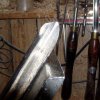This is from an interview I did with David a few years back
http://www.ellsworthstudios.com/interviews/interviewDavidEllsworth.pdf
Steve: What about the "Irish grind". Which came first, you or Liam O'Niell? What have you done to this seemingly radical departure from the standard bowl gouge design?
David: I was first exposed to the ‘side grind’ gouge through Liam O’Neill in 1982.
He, Michael O’Donnell, Richard Raffan and Ray Key had all been working with
the concept in the UK, and each had their own variations of the design. What I did was to further modify the tip shape by broadening the bevel and arching the edge until I got the right proportion between edge sharpness to bevel durability.
This is particularly important because I use the edge of the gouge at an elevated angle of 45 degrees across the wood to ‘shear’ the surface for the final cut on the outside of a form. None of the other turners did this because they were trained in the traditional manner of rubbing the bevel.
The shearing cut doesn’t use the bevel against the wood, but it does use the mass of the bevel beneath the edge to support the cut; that is, to keep it from vibrating against the wood. Equally important, my design allows the gouge to be used horizontally instead of at an elevated angle on three of it’s four primary cuts.
This means that the force of the cut is now generated directly into the tool rest instead of into the turner, with the result that the cut is more efficient and the turner is less fatigued. In fact, the tool is so specific that if you put the same long edge on a gouge with a smaller diameter shaft, you loose the mass that’s needed to support the edge and, therefore, the efficiency of the tool to do a proper job.
What’s most important about this gouge design is that it was developed out of need and by people ‘in the field’, rather than on a drawing board. While its design is unique compared to traditional bowl gouges, its efficiencies are based on sound design principles.

